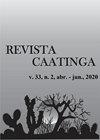巴西北部大德州半干旱地区地下坝区的水质
IF 0.9
4区 农林科学
Q3 AGRONOMY
引用次数: 0
摘要
摘要联邦公共机构已将地下大坝的融资作为减少巴西农村半干旱地区缺水的一项战略。这项工作的目的是在2018年旱季结束和2019年雨季结束时,评估巴西北里奥格兰德州用于农业灌溉的地下大坝的水质。使用Statistica 7.0软件,通过多变量分析确定了对水质影响最大的变量。结果表明,雨季过后,与大坝水中盐度和离子毒性相关的变量浓度下降,而与局部灌溉系统堵塞相关的变量则增加。地下堤坝区域的盐度、碱度和/或毒性与土壤地质成分的自然矿化有关;然而,它们也受到具有海洋吸湿核的降雨、农村集群和畜栏的存在以及筑坝区有机物分解的影响。在两个采样期内,与盐度相关的变量对这些大坝内的水化学变化表现出更高的影响;电导率和氯离子是最显著的变量。本文章由计算机程序翻译,如有差异,请以英文原文为准。
Water quality in underground dam areas in the semiarid region of rio grande do norte, Brazil
ABSTRACT The federal public agencies have prioritized the financing of underground dams as a strategy to decrease water scarcity in rural semiarid regions in Brazil. The objective of this work was to evaluated water quality in underground dams, for agricultural irrigation purposes, in Rio Grande do Norte, Brazil, at the end of the dry season in 2018 and at the end of the rainy season in 2019. The variables with the greatest impact on water quality were identified through multivariate analysis, using the software Statistica 7.0. The results showed that concentrations of variables correlated with salinity and ion toxicity in water of the dams decreased after the rainy season, whereas those correlated with clogging of localized irrigation systems increased. Salinity, sodicity, and/or toxicity in areas of underground dams were correlated with natural mineralization of geological components of soils; however, they also were affected by rainfall with marine hygroscopic nuclei, presence of rural clusters and corrals, and decomposition of organic matter in the damming area. The variables correlated with salinity presented higher effect on the hydrochemical variability of water within these dams in both sampling periods; electrical conductivity and chloride ions were the most significant variables.
求助全文
通过发布文献求助,成功后即可免费获取论文全文。
去求助
来源期刊

Revista Caatinga
AGRONOMY-
CiteScore
2.10
自引率
11.10%
发文量
67
审稿时长
6-12 weeks
期刊介绍:
A Revista Caatinga é uma publicação científica que apresenta periodicidade trimestral, publicada pela Pró-Reitoria de Pesquisa e Pós-Graduação da Universidade Federal Rural do Semi-Árido – UFERSA, desde 1976.
Objetiva proporcionar à comunidade científica, publicações de alto nível nas áreas de Ciências Agrárias e Recursos Naturais, disponibilizando, integral e gratuitamente, resultados relevantes das pesquisas publicadas.
 求助内容:
求助内容: 应助结果提醒方式:
应助结果提醒方式:


